Winter Trifecta |
|||||||||||||
 |
 |
||||||||||||
Knitted hat, neck-warmer and wrist warmers in DROPS Snow or DROPS Wish. The piece is worked with rib.
DROPS 225-17 |
|||||||||||||
|
------------------------------------------------------- EXPLANATIONS FOR THE PATTERN: ------------------------------------------------------- RIDGE/GARTER STITCH (worked back and forth): Knit all rows. 1 ridge = knit 2 rows. PATTERN: Hat: See diagrams A.1 and A.2. Neck-warmer: See diagrams A.1, A.3 and A.4. Wrist-warmers: See diagram A.1. The diagrams show all rows in the pattern from the right side. DECREASE TIP (evenly spaced – for neck-warmer): To work out how to decrease evenly, count the total number of stitches on the needle (e.g. 29 stitches) and divide by the number of decreases to be made (e.g. 7) = 4.1. In this example, decrease by knitting together approx. each 3rd and 4th stitch. INCREASE TIP (for neck-warmer): All increases are worked from the right side: Increase 1 stitch by making 1 yarn over On the next row purl the yarn over twisted to avoid a hole. Then work the new stitch in stockinette stitch. BINDING-OFF TIP: To avoid the bind-off edge being tight you can bind off with a larger size needle. If the edge is still tight, make 1 yarn over after approx. each 6th stitch at the same time as binding off; the yarn overs are bind off as normal stitches. ------------------------------------------------------- START THE PIECE HERE: ------------------------------------------------------- HAT – SHORT OVERVIEW OF THE PIECE: The piece is worked in the round with circular needle, bottom up. The turn-up is worked from the wrong side, the piece is then turned and the rest of the hat is worked in the opposite direction and from the right side. Change to double pointed needles when necessary. HAT: Cast on 64 stitches with short circular needle size 8 MM = US 11 and DROPS Snow or DROPS Wish. Work pattern in the round according to diagram A.1 for 12 cm = 4¾". Now turn the piece, so the rest of the hat is continued in the round but in the opposite direction. When the hat is finished the turn-up will have the same textured pattern as the rest of the hat. Continue A.1in the round. REMEMBER THE KNITTING GAUGE! Work until the piece measures 24 cm = 9½" (including the 10 cm = 4" turn-up; there is approx. 8 cm = 3⅛" left to finished length – work to desired length). Continue with A.2 (= 4 repeats of 16 stitches). When the diagram is finished in height, there are 32 stitches. Work 2 rounds with knit 1 / purl 1. Then knit all stitches together 2 and 2 = 16 stitches. Knit 1 round. Knit all stitches together 2 and 2 = 8 stitches. Cut the strand, pull it through the remaining stitches, tighten and fasten well. The hat measures approx. 35 cm = 13¾" (= 25 cm = 9¾" with 10 cm = 4" turn-up). ------------------------------------------------------- NECK-WARMER – SHORT OVERVIEW OF THE PIECE: The piece is worked back and forth in 2 sections, with circular needle and is sewn together at the shoulders. A double neck is worked to finish. FRONT PIECE: Cast on 43-45 stitches with circular needle size 8 MM = US 11 and DROPS Snow or DROPS Wish. Work rib as follows: 1 edge stitch in GARTER STITCH – read description above, A.1 until there are 2 stitches left, work the first stitch in A.1, 1 edge stitch in garter stitch. Continue this pattern back and forth. When the rib measures 4 cm = 1½", work the next row from the right side as follows: Work A.3 over the first 7 stitches, knit 29-31 and decrease 7 stitches evenly over these stitches – read DECREASE TIP, work A.4 over the last 7 stitches = 36-38 stitches. Change to circular needle size 9 MM = US 13. Continue with stockinette stitch and pattern over the 7 stitches on each side. REMEMBER THE KNITTING GAUGE! When the piece measures 5 cm = 2", increase 1 stitch on the inside of the 8 stitches on each side – read INCREASE TIP (= 2 stitches increased). Increase like this every 5 cm = 2" a total of 3 times on each side = 42-44 stitches. Continue working until the piece measures 20-22 cm = 8"-8¾". Now place the middle 8 stitches on a thread for the neck and each shoulder is finished separately. Left shoulder: Work the next row from the right side as follows: Work pattern as before until there are 5 stitches left before the neck, knit 2 together, knit 2 and 1 edge stitch in garter stitch. Work 1 row back from the wrong side as before. Continue back and forth like this, decreasing for the neck on each row from the right side a total of 4 times = 13-14 stitches. Continue working until the piece measures 28-30 cm = 11"-11¾". Bind off with knit from the right side. Right shoulder: Work the next row from the right side as follows: 1 edge stitch in garter stitch, knit 2, slip 1 stitch as if to knit, knit 1 and pass the slipped stitch over (= 1 stitch decreased), work the rest of the row as before. Work 1 row back from the wrong side. Continue back and forth like this, decreasing for the neck on each row from the right side a total of 4 times = 13-14 stitches. Continue working until the piece measures 28-30 cm = 11"-11¾". Bind off with knit from the right side BACK PIECE: Cast on 43-45 stitches with circular needle size 8 MM = US 11 and DROPS Snow or DROPS Wish. Work rib as follows: 1 edge stitch in garter stitch, A.1 until there are 2 stitches left, work the first stitch in A.1, 1 edge stitch in garter stitch. Continue this pattern back and forth. When the rib measures 4 cm = 1½", work the next row from the right side as follows: Work A.3 over the first 7 stitches, knit 29-31 and decrease 7 stitches evenly over these stitches, work A.4 over the last 7 stitches = 36-38 stitches. Change to circular needle size 9 MM = US 13. Continue with stockinette stitch and pattern over the 7 stitches on each side. When the piece measures 5 cm = 2", increase 1 stitch inside 8 stitches on each side – remember INCREASE TIP (= 2 stitches increased). Increase like this every 5 cm = 2" a total of 3 times on each side = 42-44 stitches. Continue working until the piece measures 26-28 cm = 10¼"-11". Now place the middle 14 stitches on a thread for the neck and each shoulder is finished separately. Continue by binding off 1 stitch for the neck = 13-14 stitches on the shoulder. Continue working until the piece measures 28-30 cm = 11"-11¾". Bind off with knit from the right side. Work the other shoulder in the same way. ASSEMBLY: Sew the shoulder seams together with grafting stitches, inside the bind-off edge. DOUBLE NECK: Knit up approx. 64 stitches around the neck, from the right side and inside the 1 edge stitch, with circular needle size 8 MM = US 11 and DROPS Snow or DROPS Wish. The number of stitches should be divisible by 2. Work A.1 in the round. When the neck measures 20 cm = 8", bind off with knit over knit and purl over purl. It is important the edge is not tight – read BINDING-OFF TIP. Fold the neck double to the inside and sew down. To avoid the neck being tight and the neck rolling outwards, it is important the seam is elastic. ------------------------------------------------------- WRIST-WARMERS – SHORT OVERVIEW OF THE PIECE: The piece is worked in the round with double pointed needles. WRIST-WARMER: Cast on 24 stitches with double pointed needles size 8 MM = US 11 and DROPS Snow or DROPS Wish. Knit 1 round. Then work A.1 in the round. REMEMBER THE KNITTING GAUGE. When the piece measures 10 cm = 4", increase 2 stitches as follows: Knit 1 twisted, purl 1, 1 yarn over (= 1 stitch increased), work the next 11 stitches as before, purl 1, 1 yarn over (= 1 stitch increased), work the last 11 stitches as before. You have increased 1 stitch on each side of the piece = 26 stitches (work the yarn overs twisted on the next round and then purl the new stitches). Continue with knit-twisted over knit-twisted and purl over purl. When the piece measures 16 cm = 6¼", bind off with knit over knit and purl over purl – read BINDING-OFF TIP. Work 1 more wrist-warmer in the same way. |
|||||||||||||
Diagram explanations |
|||||||||||||
|
|||||||||||||
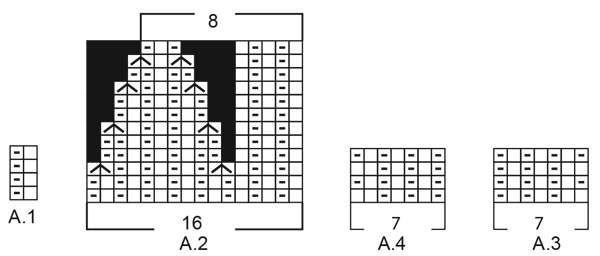
|
|||||||||||||
|
Have you made this or any other of our designs? Tag your pictures in social media with #dropsdesign so we can see them! Do you need help with this pattern?You'll find tutorial videos, a Comments/Questions area and more by visiting the pattern on garnstudio.com. © 1982-2024 DROPS Design A/S. We reserve all rights. This document, including all its sub-sections, has copyrights. Read more about what you can do with our patterns at the bottom of each pattern on our site. |
|||||||||||||








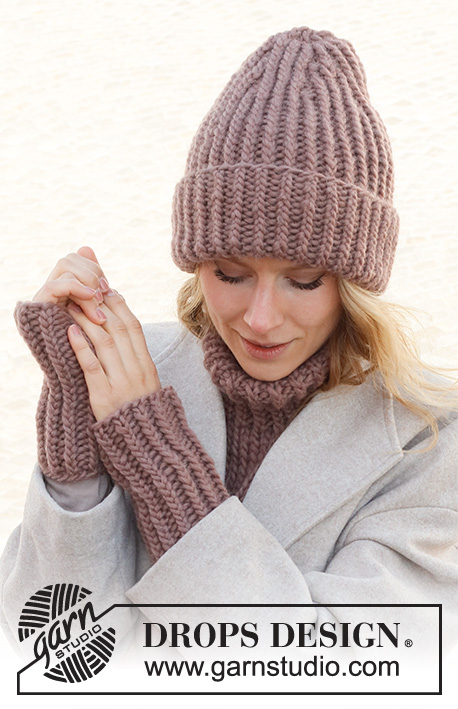

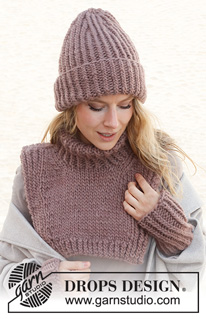
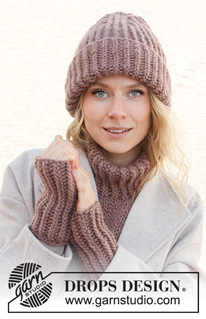
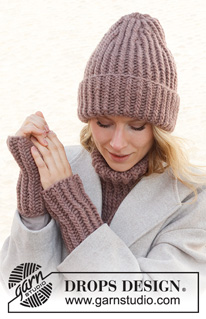











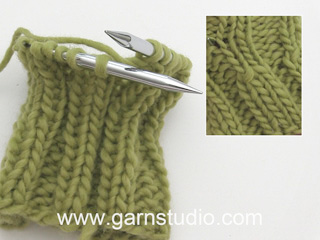


























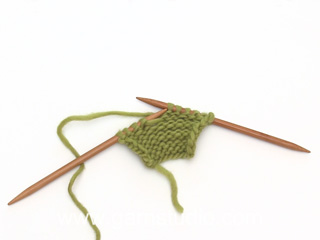























Comments / Questions (19)
Hello, thank you for such a quick response. I think so. Can I confirm then that the pattern changes to k1, p1, purl 2 together at 16. With A2, the explanations means a blank box is knit 1 twisted from right side, put 1 twisted from wrong side. And the box with a dash is purl 1 from right side, knit 1 from wrong side. And A2 has these dashes so I thought it was to read (purl 2 together, purl one from right side, knit one from wrong side. But I should ignore this and the diagram explanation? TY!
19.11.2021 - 20:43DROPS Design answered:
Dear Christina, hat is worked in the round, this means you will always work rib with K1 twisted/P1; the fisrt 2 rounds in A.2 are worked over 16 sts, you will start decrease as shown in diagram on row 3 in A.2, and there will be 8 sts in each A.2 when diagram is done (black square are for decreased sts). Since hat is worked in the round, you will always decrease by P2 tog just as shown in diagram. Happy knitting!
22.11.2021 - 07:28I’m having trouble with A2. When I am on row 3 (which starts with purling 2 together) it’s supposed to be 16 stitches x 4. But 16 stitches takes you to the second purl decrease in that row. Thereafter there’s only 12 stitches which makes 28, so the pattern would only apply to 56 stitches but I have 64. Am I missing something?? Thank you!
18.11.2021 - 23:32DROPS Design answered:
Dear Christina, work A.2 in the round reading every row from the right towards the left, this means on 3rd row you will decrease 2 sts (= there will be 14 sts in each A.2 instead of 16 sts): (K1, P1, K1, P1, K1, P2 tog, P1, K1, P1, K1, P1, K1, P1, P2 tog)= 14 sts x 4 in the round = 56 sts remain after 3rd round has been worked. Can this help?
19.11.2021 - 07:38Thank you so much again. The problem is I don't know how to do K1 twisted or the P1 twisted! Sorry about this! Sandra
18.11.2021 - 10:09DROPS Design answered:
Dear Sandra, then we have 2 videos for you: This one shows how to knit a twisted stitch (= work into back of stitch instead of front loop) and this one shows how to purl a twisted stitch = work into back loop instead of into the front loop as usual. Happy knitting!
18.11.2021 - 17:09Thank you so much for getting back to me. the problem I have though is with the K1 twisted and the P1 twisted stitches. I've watched numerous videos and they all seem to involve working 2 stitches for the twist and then a purl or knit, so 3 stiches in total. Is this correct or is there a different way of twisting the stitch? Thank you, Sandra
17.11.2021 - 12:10DROPS Design answered:
Dear Sandra, I might not understand your question properly, sorry in advance, when working the rib as diagram A.1, repeat (K1 twisted/P1) from RS, this means the K twisted will be P twisted from WS and the P1 will be knitted from WS. Can this help?
17.11.2021 - 16:41Help! I can't work out how to do A1 on the Winter Trifecta neck warmer pattern.
11.11.2021 - 15:11DROPS Design answered:
Dear Mrs Clayton, A.1 is worked as follows back and forth: from RS: K1 twisted, P1 - and from WS: K1, P1 twisted. When working in the round work: K1 twisted, P1. Read more about diagrams here. Happy knitting!
11.11.2021 - 17:34Knitting the winter trifecta hat , starting with turn up, working wrong side so do I start knitting P1 twisted, k1 for the 14 cm or K1, P1twisted. I'm confused because I'm knitting in the round and chart is usually read right to left but for this do I read chart left to right for turn up since it is the wrong side being worked .
07.11.2021 - 19:28DROPS Design answered:
Dear Debbie, that is ecaxtky the trick in this hat, you knit the turnup, pattern as normal, then turn the thing over, and from the other side you knit the pattern again as normal. Thus, when you turn up the edge, its RS will be shown. Happy Stitching!
07.11.2021 - 21:16Bonjour Je ne comprends pas comment faire pour retourner le revers du bonnet de l'envers vers l'endroit sur des aiguilles circulaires . Pouvez vous m'aider Svp ? Ou bien avez vous une vidéo ? Merci
04.11.2021 - 04:32DROPS Design answered:
Bonjour Marie, retournez simplement votre ouvrage pour tricoter désormais dans l'autre sens, le début de l'ouvrage se retrouve sur l'envers pour qu'ainsi, quand vous retournerez le bas du bonnet, le revers sera sur l'endroit. Bon tricot!
04.11.2021 - 06:53Hello, I'm very new at all this so I'm not totally sure what it means to turn the piece (I'm knitting the hat), I've googled it and all I can find is the wrap and turn in short rows used when making socks and it doesn't seem to be right for this piece. Is there a video explaining this? Thank you so much
27.10.2021 - 14:55DROPS Design answered:
Hello, You work the turn-up then you turn the work from the right side to the wrong side (which means that "technically" you have worked the turn-up on the wrong side). When the hat will be finished the turn-up will be turned up to be on the right side. Have a great week!
28.10.2021 - 09:20Winter Rose
04.08.2021 - 02:38